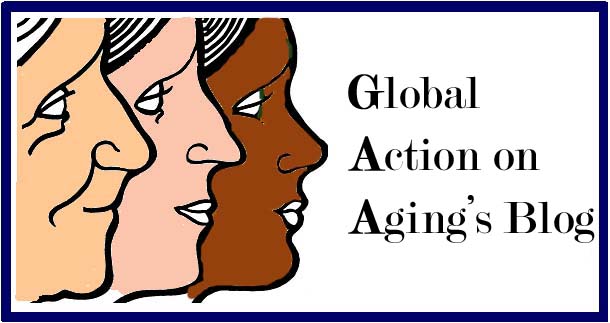Dear Global Action on Aging Friend,
Latin Americans are making vigorous efforts to end elder abuse throughout Latin America and the Caribbean. I think you will be interested in reading their materials. . .wherever you live. Here is statement that CORV prepared for the June 15th World Elder Abuse Awareness Day.
STATEMENT OF CORV
STOP THE ABUSE AND MALTREATMENT!
OLDER PERSONS CLAIM FULL RECOGNITIONAS PERSONS WITH RIGHTS AND NOT AS CLIENTS OR PATIENTS 1. In our meeting as a civil society held in Costa Rica in 2012 we expressed that "therights of older persons continue to be violated. Actions in relation to older persons
and aging lack coherence between the speech that emphasizes these rights and the
compliance thereof. In this context, older persons continue to suffer from multiple
discrimination; different types of abuse and violence, poverty, and lack of access
to justice " (Declaration of Tres Rios, par. No. 1).
2. One year since our meeting, in which we agreed to move from plan to action, we
now declare that IT IS POSSIBLE TO STOP THE ABUSE ANDMALTREATMENT OF OLDER PERSONS, recognizing health as a human
right and not a commodity. Each time attention is postponed, medication is not
provided, or access to required health services is denied, an assault is committed on
the lives of older persons and international agreements that demand priority and
proper and timely attention be given are violated. THE VIOLATION OF OUR
RIGHT TO HEALTH IS ALSO A VIOLATION OF OUR RIGHT TO LIFE!
3. The lack of income, low pensions, non-recognition or not granting of universal
pension and non-indexation of pensions to the cost of living is one of the worst
forms of discrimination and reproduction of poverty among older persons. It is
inconsistent that in legislative frameworks the aged over sixty years are
recognized, while for providing non-contributory pension the age is set at sixty-five.
In this case it is an abuse that comes from the political, administrative and
legislative institutions themselves, which is identified as STRUCTURAL ABUSE.
pension and non-indexation of pensions to the cost of living is one of the worst
forms of discrimination and reproduction of poverty among older persons. It is
inconsistent that in legislative frameworks the aged over sixty years are
recognized, while for providing non-contributory pension the age is set at sixty-five.
In this case it is an abuse that comes from the political, administrative and
legislative institutions themselves, which is identified as STRUCTURAL ABUSE.
4. It is a violation of the rights of older persons not to have an adequate standard
of living that guarantees them and their family, health, wellbeing, and in particular
food, clothing, housing, medical care, the necessary social services, the right to
security in the event of unemployment, sickness, disability, widowhood, old age or
other lack of livelihood in circumstances beyond their control. (Art 25. Declaration
of Human Rights).
of living that guarantees them and their family, health, wellbeing, and in particular
food, clothing, housing, medical care, the necessary social services, the right to
security in the event of unemployment, sickness, disability, widowhood, old age or
other lack of livelihood in circumstances beyond their control. (Art 25. Declaration
of Human Rights).
If you wish to learn more or sign on to this Statement, contact Enrique Mac Iver in Santiago, Chile, at this phone number (56-2) 633 0032 in Chile or at E-mail: sociedadcivilpersonasmayores@gmail.com
Coordinación Regional de Organismos de la Sociedad Civil
de América Latina y el Caribe sobre Envejecimiento, CORV POVERTY IS THE WORST FORM OF VIOLENCE (Mahatma Gandhi) IT MAKES
THE REALIZATION AND THE EXERCISE OF SOCIAL, ECONOMIC AND
CULTURAL RIGHTS, INCLUDING POLITICAL AND CIVIL RIGHTS IMPOSSIBLE.
5. We note that our countries have already signed three international agreements aimed at full recognition of the elderly, which are the Regional Strategy on Aging
(2003), the Declaration of Brasilia (2007) and the Charter of San Jose on the rights
of older persons in Latin America and the Caribbean (2012). However, these agreements have not been translated in facilitating real ways of participation of older personsand their organizations in decision-making at all levels, as indicated in the actions recommended in the Madrid Action Plan on Aging (2002) and reaffirmed in the cited agreements. The failure to consider the will and existence of older persons and civil society institutions, devoted to working for the rights of older persons, is a kind of discrimination that reveals another form of abuse, structural abuse.
6. On the occasion of World Elderly Abuse Awareness Day 2013 as theRegional Coordinator of Civil Society Organizations on aging and old
age, CORV, we express our solidarity and we encourage social struggles
of the organizations of older persons and of workers in the region for their rights
for decent pensions, for timely and preventive health and for integration and
exercise of all the rights, the real path of Good Treatment and of Good Living,
which is the cry of every voice, every face of older persons, and of all citizens.
June 2013
With thanks for your solidarity, Susanne Paul at Global Action on Aging


